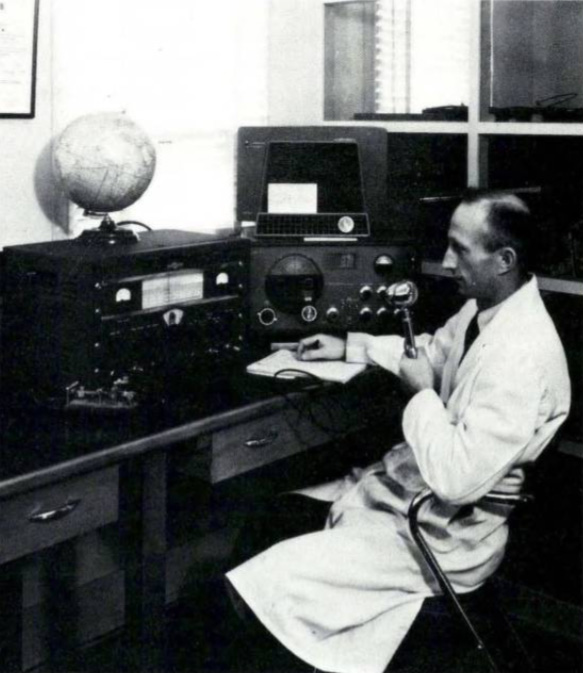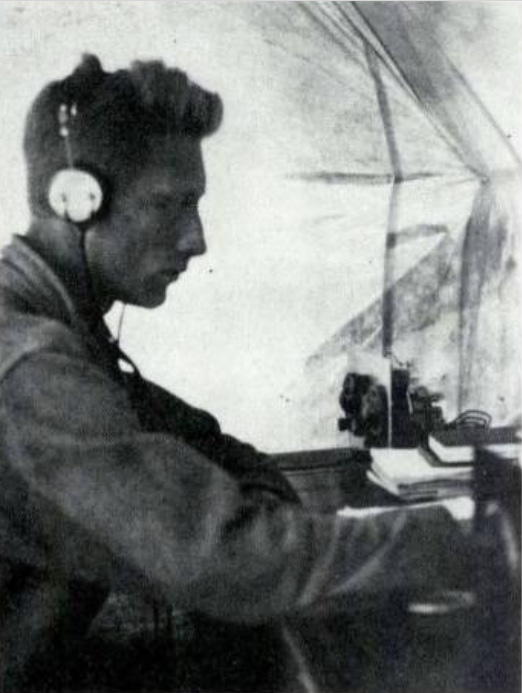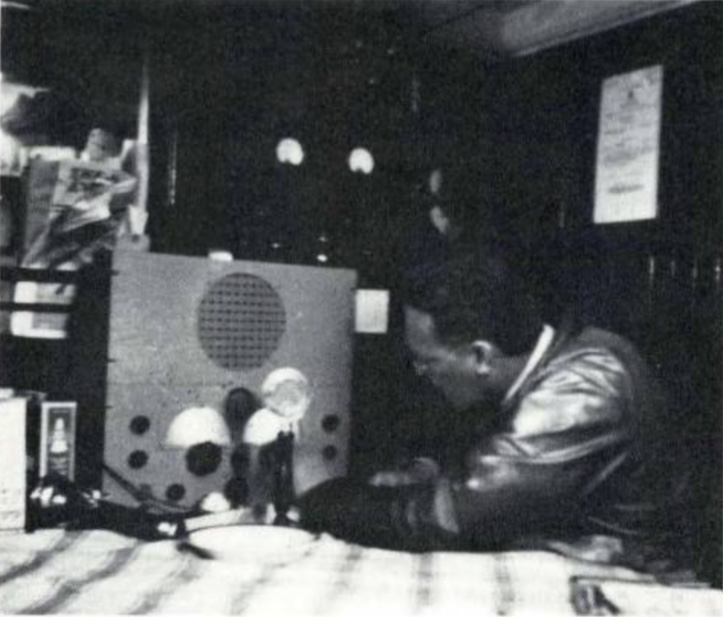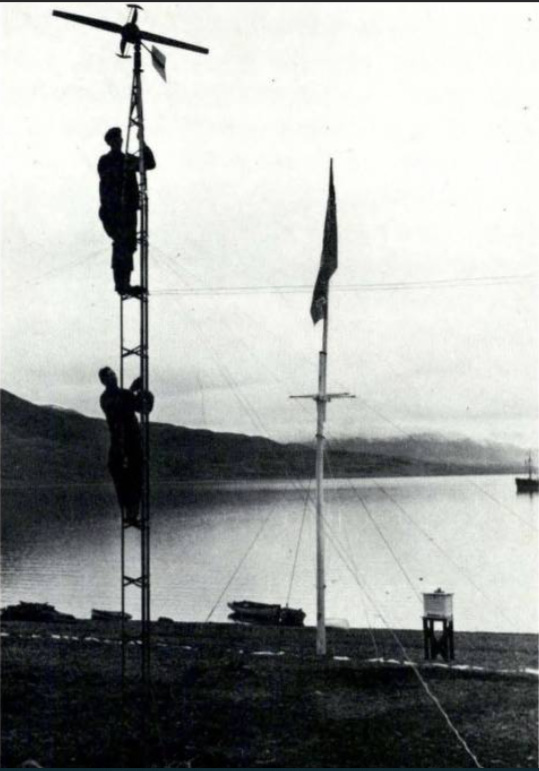The Saga of Northern Radio

IT WAS EARLY SEPTEMBER when the Hudson’s Bay Company steamer Nascopie anchored opposite the trading post of the Arctic Bay, Baffin Island. Along with the supplies for the year 1936–37 was a new manager for the post, Alan Scott. The bare rocky hills of Baffin Island probably reminded him of the Grampian Mountains near his home town, Aberdeen.
The difference was the isolation of Arctic Bay compared to northeastern Scotland where he has just spent a year-long leave. Leaving home to return to northern Canada must have been especially poignant for him because during this vacation he had met and fallen in love with Eileen Wallace. Only once was there the chance he might exchange letters with her before the steamer returned next September. In March or April he would send a dog-team south with trade reports and mail. With luck, it would bring him a letter on its return, along with orders from the Company.
Scott’s situation was not unusual in Canada’s arctic in the mid-1930s. The majority of traders, missionaries, prospectors and members of the Royal Canadian Mounted Police were equally as isolated. In the next few years, however, Scott was witness to a series of events that changed the lives of all those living in the North. His employer, the Hudson’s Bay Company, issued radio receivers and transmitters to all its northern trading posts, allowing them to communicate directly with each other and with the outside world. Radio destroyed the barrier to communications caused by climate and distance, just as the airplane was to simplify travel.
The use of radio for northern communications started in the years before the First World War with the establishment of two radio stations by the Government of Canada. The stations, located at The Pas and Fort Nelson, were part of the plan to build a railway line neared completion in the late 1920s, more radio stations were built on the northern coastline along the route that ships would follow as they sailed into the port.
By 1936 when Alan Scott was landing at Arctic Bay, the railway and string of guiding radio stations had been completed and the harbor opened. Most of the radio stations were operated in the shipping season; only the stations at Coppermine and Chesterfield Inlet were ‘on the air’ all year round. In 1930, a day or two before Christmas, these two stations had been instructed to make daily broadcasts of news and personal messages. The Hudson’s Bay Company was to use these government stations as links in its own radio network.
“Over the aerial at Arctic Bay was flashed a proposal of marriage, an account of a wedding, news of a birth, instructions from a doctor, and the story of a christening.”
The Beaver, December 1939

The decision to study the feasibility and usefulness of a radio network was made by the Company in 1934. Aboard the Nascopie on her trip north that summer was Fur Trade Commissioner Ralph Parsons, and Governor of the Company Sir Ashley Cooper. These men talked at length with a summer employee working as a radio operator on the shop, George Horner, believed the speed and reliability of radio communications could significantly enhance the Company’s business operations.
Using immediacy, speed and reliability of radio the Company could adjust the prices paid for furs in northern stores to reflect changes in world fur prices. Its store managers could inform the Canadian headquarters head offices in Winnipeg in advance about the pelts — the quantity and grades — that would be off-loaded from the Nascopie. Parsons, who had spent all his working life in the fur trade, also knew the positive impact that improved communications would have upon his northern staff.
With 7 uniquely curated newsletters to choose from, we have something for everyone.

In the next two years, two of the Company’s young apprentices who held amateur radio licenses, demonstrated that low-power radio sets could operate in the North. G.C.M. Collins at Norway House and D.G. Sturrock in the Western Arctic were able to communicate with other amateurs all over the world from their isolated locations.
Sturrock was the first to use short-wave radio communication in the fur trade for private commercial purposes. As an apprentice at Tuktoyaktuk in the summer of 1934 he operated a radio station with a small dry-battery transmitter, and set up the same station at Cambridge Bay when transferred there in the fall of 1934.
The Hudson’s Bay Company obtained a private commercial license for Sturrock to enable him to carry on two-way communication of Company business with the government radio station at Coppermine. This was continued when he was transferred to Gjoa Haven in the fall of 1935.
As early as 1928, W.E Brown, while post manager at Wager Inlet, had conducted experiments with a transmitter made from parts of an obsolete radio receiver and had succeeded in transmitting a CW (Morse Code) signal to a maximum distance of about half a mile. Late in 1934, while Brown was a district manager working out of the Winnipeg office, he showed Fur Trade Commissioner Ralph Parsons and his assistant James Cantley a CW transmitter he had recently built.
I explained to Mr. Parsons how little it would cost to supply each post with a CW transmitter and receiver. Brought his attention to the fact that through schedules with the Marine Radio Stations at Chesterfield Inlet, Churchill and Port Harrison the company transmitters could readily get messages out to head office [at Winnipeg] and receive messages from head office. Mr. Parsons turned into Jim Cantley and told him to make note to the effect that they would install four sets in the Straits the following summer. He said he supposed the Marine Radio Station at Nottingham Island could handle them.
The radio operator on the Nascopie, George Horner was a very competent man and I agreed with Ralph Parson when he asked me if I thought he would be able to design the necessary equipment.

Ralph Parson asked George Horner to carry out a series of experiments during the summers of 1935 and 1936 when he was again working on the Nascopie. Using the radio in the steamer to communicate with sets he had left at carefully chosen locations, he investigated the characteristics of radio transmissions in the Arctic. The study was a success and Parsons asked Horner, then in his last year of engineering studies at the University of New Brunswick, to make plans for a network of radio stations.
At the same time as the Company had under consideration the establishment of a network, a request for help was received from the newly formed federal Department of Transport. In a letter to Ralph Parsons written in the spring of 1937, the Controller of Radio, (located in Ottawa) W.A. Rush explained that the government wanted to expand radio coverage by installing a year-round station on the east coast of Hudson Bay, preferably one of the Company’s posts.
Not only would this relieve supply problems, but would give the radio operators some social contacts. Rush thought that either the post at Great Whale River or at Port Harrison would be ideal. Parsons seized the opportunity and soon reached an agreement with Rush, that in return for its co-operation the Company would issue licences for a number of radio stations. Also the government stations would co-operate in the operation of the network.

In April 1937, Parsons hired Horner as the Company’s radio engineer. He had only a few months available before the Nascopie sailed. He moved to Winnipeg and set up an office and laboratory in the Company’s Canadian headquarters. There he put together the equipment for the first stations and trained operators for sets. Luckily, three managers from posts in the Ungava district of northern Quebec were in Winnipeg waiting to return to work from leave.
Horner taught the three men, and a young apprentice who had just joined the Company, to operate and maintain the radio sets that were to be issued to them. The apprentice, M. Ahlbaum, was given a short course in meteorology by the Canadian Meteorological Service in addition to his normal training. Ahlbaum was assigned to Arctic Bay which, in addition to being one of the posts to receive a radio, was to become the most northerly weather station in Canada.
The radio sets and the equipment to power them were models of ingenuity. Horner’s choices show he had a thorough understanding of all the problems likely to be encountered in the Arctic, given the lack of resources at the isolated trading posts.
The first problem shown by his tests and the experiences of the Company’s amateur radio operators, was that dry batteries could not be used to provide the needed power. Not only were a large number needed to operate a transmitter and receiver for a year, but they had to be kept from freezing. This was a major drawback because, in the treeless North coal was used to heat the trading posts. It came with the other supplies on the Nascopie and it was not unusual for the steamer to miss an annual delivery because of adverse ice conditions.
Save as much as 40% off the cover price! 4 issues per year as low as $29.95. Available in print and digital. Tariff-exempt!
As a result, a post might not have enough fuel to heat the living quarters through a winter. Horner devised an ingenious solution to the energy problem: he purchased a system of windmill-powered generators charging a series of wet-cell accumulators, much like car batteries. As long as the generator kept them fully charged, the batteries could not freeze. Wincharger Corporation of Iowa City had developed this equipment for sale to isolated farms on the prairies.
The radio transmitters and receivers in use in the 1930s used electronic tubes and required two separate voltages to power them. The low voltage came directly from the accumulators but the high voltage presented a problem. Horner finally decided on a voltage inverter: an instrument developed to power automobile radio receivers.
The inverter used a mixture of mechanical and electrical means to produce the required direct-current high voltage. The receiver and transmitter chosen by Horner were small and compact by the standards of the age; each was about the size of a toaster. The equipment fitted neatly onto a small table with the batteries tucked underneath or it could be built into a bookcase. Outside the building on a tower, or perhaps on top of a roof, was the wind-powered generator.
The small size of the complete station and its simple inexpensive equipment were important factors. It did not take up too much room in cramped living quarters and was easy to transport and install. The choice of compact equipment, however, meant that two important compromises had to be made. First, the sets could not transmit or receive voice communications; they used International or Morse code. Second, the transmitter was low-powered. It only had an output of twelve watts, little more than a modern CB set. The use of code to send the signals instead of voice offset the limitation of low power.
Experience was to show that the transmitter had a long range when atmospheric conditions permitted. In spite of this, messages could not be received at the Company’s offices in Winnipeg with any regularity. Arrangements were therefore made for the posts to communicate directly with their nearest Canadian government radio station so as to ensure reliable communications.
Arctic Bay, for instance, was to use the government station on Nottingham Island, several hundred miles to it south. The government stations acted as relay points, saving messages for the Company’s trading posts until they called in at certain scheduled times and then forwarding their telegrams. Because Arctic Bay had been designated a weather station, its schedule required daily calls at 5:45, both morning and evening.

The Arctic Bay radio was installed for Alan Scott in September 1937 by George Horner and the ship’s carpenter, Clem James. One of the first messages sent out by Scott was a proposal of marriage to Eileen Wallace. She accepted by letter and the following year travelled north on the Nascopie. The two were married by the Anglican Bishop of the Arctic, A.L. Fleming.
The network expanded from four stations in 1937 to fifty-four by the summer of 1939. Unexpectedly, they had a much greater impact on domestic life in the Arctic than on the Company’s commercial operations. Almost from the beginning the sets were installed in the living quarters, sometimes in the apprentices’ bedrooms.
At first, it was the apprentices who used to spend several hours each evening communicating with friends at other posts but soon the manager of the post and his wife and often some of the Inuit employees learned code and were using the sets. Because the manager and apprentices had to go on extended journeys away from their posts, their wives in particular became adept at radio operation. For the women, radio significantly reduced one of the worst aspects of life in the North, its isolation.
Invariably the sets were used soon after their installation for emergency calls. Often the post managers used their radios to talk to the Canadian government doctor attached to the station at Chesterfield Inlet. One post reported sending over 12,000 words in International Code in a year on medical matters alone. Most of these messages concerned health problems in the Inuit and Indian communities. When satisfactory treatment could not be given at the post, the manager was to call in a plane to fly his patient out to hospital. The records show that many of the first flights into northern posts were mercy missions. The radio operator at the post would inform the pilot of the local weather conditions and tell him where to land. The existence of the radio sets significantly speeded up the expansions of air service into Canada’s North.
The Scotts themselves provided an example of how quickly the new facility became an important factor in the lives of those at the northern posts. Their daughter was born on 6 July 1939, just two days before the Nascopie was due to sail from Montreal. Eileen Scott was attended at her daughter’s birth by two Inuit mid-wives whil Alan Scott received medical advice from the doctor at Chesterfield Inlet, via his radio. After the birth, the Scotts were able to send south by radio an order for a complete layette, specifying the colour — pink. The baby clothes and other supplies were purchased by friends just in time to be loaded onto the steamer and be delivered in September. A few years earlier, the Scotts would have waited over a year for their order to be filled.
Probably the most dramatic use of the combination of radio and aircraft for rescue purposes occurred in 1943. The Company had opened an isolated post, Fort Ross, on the shore of Prince Regent Inlet where pack ice often made access impossible. In the summer of 1942 and again in 1943, the Nascopie failed to reach the post. With insufficient food, fuel and supplies left for the winter of 1943–44, the decision was made to attempt a rescue of the manager, Bill Heslop, his wife Barbara and Darcy Munro, the clerk at the post. One of the largest transport planes in the United States Army Air Forces was used to fly two trips into Fort Ross. The trading post was at the extreme limit of the aircraft’s range for a return flight.
The first trip carried in supplies which, along with a man to help Bill Heslop choose and prepare a landing site, were parachuted to the beleaguered post. A few days later, the rescue mission was successfully completed when the plane landed on the smooth ice of a nearby lake. The trip was touch and go! Bad weather was moving in fast and, because of weight, the Heslops and Darcy Munro had to leave most of their personal belongings and a pet husky behind. The task would have been impossible without the radio set at the post and the wind-powered generator that kept its batteries charged. The radio provided all the information needed by the pilots before they took off and its signals guided the aircraft during the long flight north. In the two years or more that the post had been inaccessible, the radio had provided the Heslops and Darcy Munro with their only link to the outside world.
In the spring of 1940 the fur-trade radio network was integrated into the war effort by the Canadian government. Personnel at selected radio-equipped posts in the eastern Arctic were enrolled in the Aircraft Detection Corps and given the task of reporting strange aircraft, thereby guarding against the possibility of an air raid. The daily weather information provided by some of the posts greatly increased in importance after the decision was taken in 1942 to fly aircraft directly across the Atlantic. To enable meteorologists to make more accurate forecasts, the number of posts supplying data was increased. At Arctic Bay, and a few other posts, the Meteorological Service established permanent bases with gasoline-powered generators, powerful radio sets and teams of specially trained observers.
These stations provided hourly reports to weather forecasters in the South. The Company was asked to provide buildings and help to supply these bases. In most of the posts, however, Company personnel, rather than government employees, took on the job of collecting the additional information. Depending on their location, these people read their instruments three to ten times daily and then transmitted the data to their control stations at strictly scheduled times. This was a considerable amount of additional work. Most of the posts concerned were small—a manager and a clerk or an apprentice and perhaps their wives. The women played a key role when the men were away by taking over the task of data collection and transmission.
The use of radio and radar grew rapidly during the war and led to increasing amounts of research into the properties of radio waves. One important line of investigation was the ionosphere and its effects on radio transmissions. The Arctic was chosen as the best location for research. Once again the Company was asked to provide assistance. Using the specialized skills of its employees, it designed and constructed a series of prefabricated buildings to house the scientists and their equipment. The Company then erected the research station at its post at Clyde, on Baffin Island, three hundred miles north of the Arctic Circle. With the addition of a United States Air Force radio station at the same site, this Hudson’s Bay Company trading post came to resemble a small village.
By the end of the war, all of the Company’s 101 northern trading posts were equipped with radio transmitters and receivers. Because it was no longer possible to find the time to train personnel in Morse Code, the Company introduced voice equipment in the late 1940s. Then, in the early 1950s, the problem of interference from other stations severely threatened the reliability of the network. George Horner therefore carried out yet another series of experiments and came to the conclusion that a switch from amplitude to frequency modulation or single side-band (SSB) was the answer.
The network was by now so important to the business of the Company and the well-being of its personnel, there was no question that the large sum of money required to re-equip the posts would be forthcoming. By 1959, the Company owned the largest and most northerly single side-band radio network in the world. It was for this pioneering work that, in 1956, George Horner was elected a Fellow of the American Institute of Radio Engineers. The move to SSB transmission provided the Company with a private, interference-free communication system of enhanced range and clarity.
But telecommunications are a rapidly changing field and when George Horner retired in 1970, there were only seventy-two stations left in the network. The radio sets were being replaced by telephone microwave systems, a process that has continued through today with satellite communications which brings television to the most isolated communities. Although a few trading posts still have their radio sets, there is no longer a formal network and there are no scheduled calls made to the government radio stations, many of which have been closed.
The creation of the fur-trade radio network led to radical changes in the lives of Company employees and their customers. The ability to monitor the course of trade and change store tariffs undoubtedly assisted the Company to adjust to the economic fluctuations of the depression and the war. The radio transmitters and receivers broke down the communications barrier and eased travel by speeding up the use of aircraft. Both the radio sets and the aircraft significantly improved medical services in the Canadian North in the same way as they had in the Australian outback, even though no official “Flying Ambulance Service” was ever created in Canada. The Company’s northern personnel and their families made an important contribution to Canada’s war effort. All this would have been impossible without some means of communication with the outside world. (In contrast, the Company’s arctic posts did not hear of the outbreak of the First World War until September 1915.)
Above all, radio had the greatest effect upon family life. Radio gave the wives of Company personnel a means of reliving their sense of isolation by increasing their social and business contacts and allowing them to communicate with far-off family and friends. The women became particularly adept at using sets, and came to handle much of the business and meteorological traffic. Thus, radio increased their access to business activities and gave them new and important skills.
The fur-trade radio network was a remarkable technical achievement. On the surface, it appears as if the early stations were nothing more than a collection of “off the shelf” items. Yet this simple fact is an important point. Horner did not have the time to carry out a great deal of research into possible equipment. Nor did the Company have the capital to finance a research and development programme. The Wincharger battery sets, the automobile voltage inverters and the transmitters and receivers were items commonly available and therefore reasonably priced and with known standards of performance. What was more, spare parts for them were readily available.
The network fulfilled its designed purpose well and the Company did not hesitate to continue its investment in it. To the Company’s credit, there was never any attempt to limit the use of the network to Company business. All who lived in the North shared in its benefits. The fur-trade radio network was an important factor in the development of the North and the efforts of the Company and George Horner deserve to be a recognized part of northern history.
We hope you’ll help us continue to share fascinating stories about Canada’s past by making a donation to Canada’s History Society today.
We highlight our nation’s diverse past by telling stories that illuminate the people, places, and events that unite us as Canadians, and by making those stories accessible to everyone through our free online content.
We are a registered charity that depends on contributions from readers like you to share inspiring and informative stories with students and citizens of all ages — award-winning stories written by Canada’s top historians, authors, journalists, and history enthusiasts.
Any amount helps, or better yet, start a monthly donation today. Your support makes all the difference. Thank you!
Themes associated with this article
Advertisement








